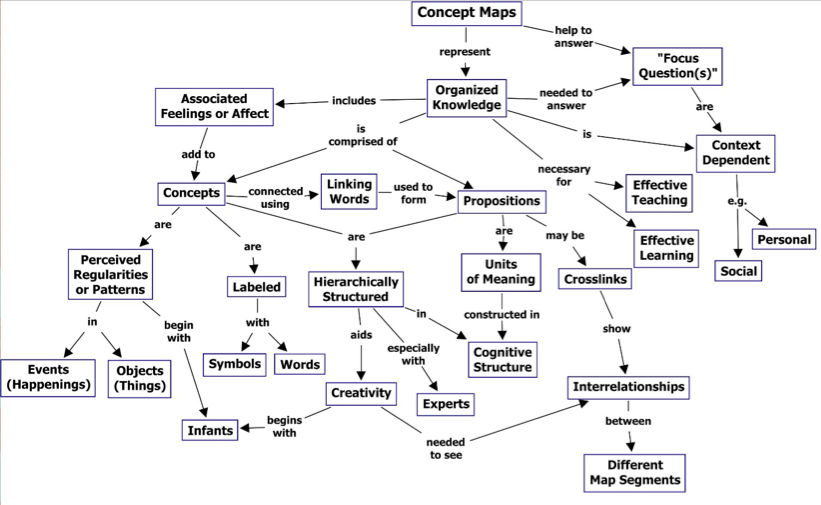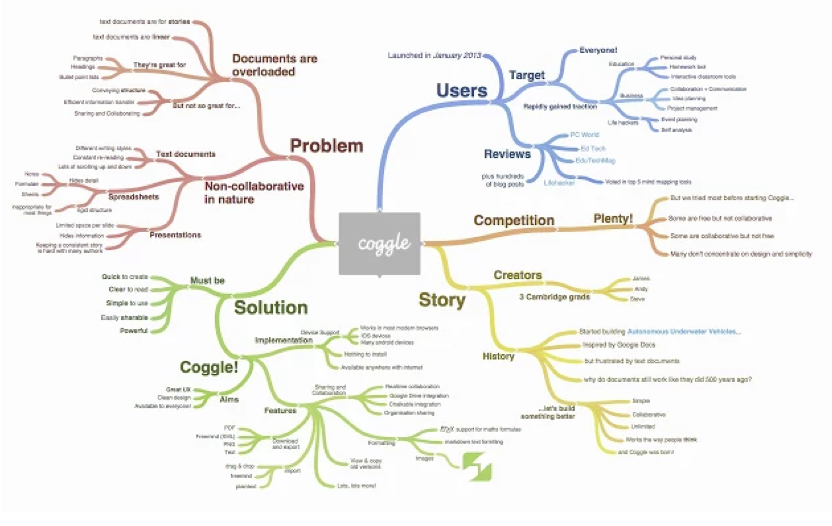This resource defines what a concept map is, gives an example, and compares the concept map to other forms of visualisation. It will help you recognise when this strategy is most useful, and find tools to help you do it quickly and well.
What is a 'concept map'?
A concept map is a visual device used for strategic analysis and planning. While the words 'concept' and 'map' are commonly used, using them together refers to something specific, and perhaps less familiar. A 'concept' is an idea or plan, and a 'map' is a simplified overview of a complex territory. A 'concept 'map' is a diagrammatic overview of key ideas associated with a particular topic, that indicates how the ideas relate to each other.
Leading proponents of concept mapping, Cañas & Novak, define concept maps as "graphical tools for organizing and representing knowledge". Basically, a concept map is a way of analysing a topic, studying it, and/or planning a new presentation of it.
When does it help to create a concept map?
Concept mapping is a powerful strategy when you're moving from reading about a topic towards drafting your own text, or when you're studying for an exam. It's a way of identifying what you think is most important, and articulating relationships between them and the logic of the discussion you want to develop and present.
How can you create one?
To make a concept map, you simply summarise what you know about a topic, on a single page in a visual diagram, and link key nouns and verbs to form simple sentences that connect things logically (see examples below). By 'simply' is meant that the result should be easy to read and not overly complex. Something that is efficient and effective to use is usually not so 'easy' to create - it might require hours of design, representing very careful thinking. Like all things design, it's the effort that goes into it that makes for a comfortable and valuable user experience in the end.
You can draw a concept map on paper or use software – both have advantages. Having your map on paper means you can stick it up on your wall and refer to it while writing or studying. This helps you keep on track. To do it digitally, you can simply use Word, or better yet, some of the great FREE software available, which makes it very easy to change a concept map once begun, and add images and links.
What's the difference between a 'concept map' and other types of visual overview?
While a concept map looks similar to a ‘mind map’, they do have different histories, advocates and purposes. A concept map is more of a careful, deep and logical analysis, a ‘model’ or diagram of knowledge that's already in the public domain. A mind map is more of a personal or group 'brainstorm', representing an emergent thinking process. Other diagrammatic techniques used to help analyse or plan texts include simple ‘graphic organisers’ and elaborate 'knowledge graphs' or ‘network visualisations’.
It doesn’t much matter how you do it or what you call it, the point is that in creating a visual overview of your topic on one page, you are effectively thinking about it, and developing control over where your discussion might go.
Example
|
Concept map |
Mind map |
|---|---|
The convention in concept mapping is to set it out to read from the top down. Mind maps are usually started in the middle of the page, and expanded by branching out fairly randomly in all directions, as various associations and lines of thought are developed.
Note that the concept map spells out logical relationships between elements, by articulating simple but grammatically complete sentences, which are clear and easy for anyone to interpret. The mind map may or may not use complete sentences to explain the connections drawn, and is often more of a personal memory aid, rather than intended as a communication to others.

